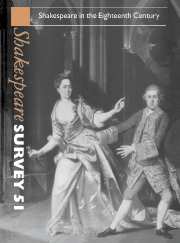Book contents
- Frontmatter
- Shakespeare and the Eighteenth Century: Criticism and Research
- Daddy’s Girls: Shakespearian Daughters and Eighteenth-Century Ideology
- Shakespeare and Clarissa: ‘General Nature’, Genre and Sexuality
- Early Georgian Politics and Shakespeare: The Black Act and Charles Johnson’s Love in a Forest (1723)
- Race Mattered: Othello in Late Eighteenth-Century England
- From Pericles to Marina: ‘While Women are to be had for Money, Love, or Importunity’
- ‘A Thousand Twangling Instruments’: Music and The Tempest on The Eighteenth-Centruy London Stage
- Double Falsehood and the Verbal Parallels with Shelton’s Don Quixote
- Eighteenth-Century Performances of Shakespeare Recorded in the Theatrical Portraits of the Garrick Club
- Eighteenth-Century Editing, ‘Appropriation’, and Interpretation
- Shakespeare Survey: Beginnings and Continuities
- Destined Livery? Character and Person in Shakespeare
- Prejudice and Law in The Merchant of Venice
- ‘Many A Civil Monster’: Shakespeare’s Idea of the Centaur
- Shakespeare’s International Currency
- Repeopling the Globe: The Opening Season at Shakespeare’s Globe, London 1997
- Shakespeare Performances in England, 1997
- Professional Shakespeare Productions in the British Isles, January–December 1996
- TheYear's Contributions to Shakespeare Studies: 1 Critical Studies
- 2 Shakespeare’s Life, Times, and Stage
- 3 Editions and Textual Studies
- Books Received
- Index to Volume 51
- General Index to Volumes 41–50
2 - Shakespeare’s Life, Times, and Stage
Published online by Cambridge University Press: 28 March 2007
- Frontmatter
- Shakespeare and the Eighteenth Century: Criticism and Research
- Daddy’s Girls: Shakespearian Daughters and Eighteenth-Century Ideology
- Shakespeare and Clarissa: ‘General Nature’, Genre and Sexuality
- Early Georgian Politics and Shakespeare: The Black Act and Charles Johnson’s Love in a Forest (1723)
- Race Mattered: Othello in Late Eighteenth-Century England
- From Pericles to Marina: ‘While Women are to be had for Money, Love, or Importunity’
- ‘A Thousand Twangling Instruments’: Music and The Tempest on The Eighteenth-Centruy London Stage
- Double Falsehood and the Verbal Parallels with Shelton’s Don Quixote
- Eighteenth-Century Performances of Shakespeare Recorded in the Theatrical Portraits of the Garrick Club
- Eighteenth-Century Editing, ‘Appropriation’, and Interpretation
- Shakespeare Survey: Beginnings and Continuities
- Destined Livery? Character and Person in Shakespeare
- Prejudice and Law in The Merchant of Venice
- ‘Many A Civil Monster’: Shakespeare’s Idea of the Centaur
- Shakespeare’s International Currency
- Repeopling the Globe: The Opening Season at Shakespeare’s Globe, London 1997
- Shakespeare Performances in England, 1997
- Professional Shakespeare Productions in the British Isles, January–December 1996
- TheYear's Contributions to Shakespeare Studies: 1 Critical Studies
- 2 Shakespeare’s Life, Times, and Stage
- 3 Editions and Textual Studies
- Books Received
- Index to Volume 51
- General Index to Volumes 41–50
Summary
Reactions against the term ‘early modern’ to describe the times in which Shakespeare wrote are gathering momentum. In spite of its title, The Project of Prose in Early Modern Europe and the New World aims to prioritize continuities between Renaissance and medieval culture rather than ‘early modern intellectual history and modern humanism’ (p. 12). In Subject and Object in Renaissance Culture, Margreta de Grazia offers an ‘anti-Early Modern’ (p. 21) reading of King Lear, remarking that it is dangerous to focus exclusively on the Renaissance as the nascence of the modern and to make Shakespeare, if not our contemporary, then an early version of ourselves. De Grazia’s fine analysis shows that such an approach does not mean abandoning the theoretical sophistication which has characterized so much recent work on the ‘early modern’.
Richard Hillman takes an equally theoretically inspired 'backwards' look in Self-Speaking in Medieval and Early Modem English Drama, an exciting study of subjectivity on stage, using key aspects of Lacan. Proposing a 'middle ground' between the extremes of historicist and humanist ideas of selfhood, Hillman traces a dramatic history of inwardness which stretches back to the medieval tradition. The mirror and the book serve as key representations of Lacanian models of selfhood, and theoretical positions are usefully signposted throughout. God, conscience and the slippery medium of language are all fundamental to the constitution of the fragile speaking subject, Hillman argues, but at the very moment of self-speaking on stage, subjectivity is threatened by aphanisis, a tendency to face away.
- Type
- Chapter
- Information
- Shakespeare Survey , pp. 289 - 301Publisher: Cambridge University PressPrint publication year: 1998

